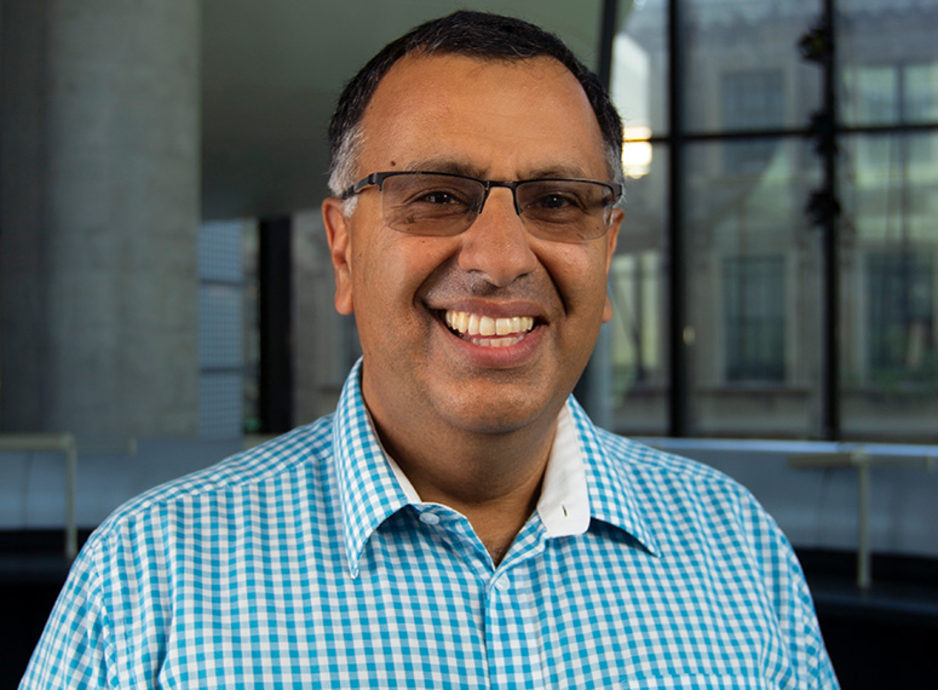From research and health care practice to education, the Leslie Dan Faculty of Pharmacy has embedded AI and emerging digital technologies as a key focus of academic plan
As artificial intelligence (AI) becomes more powerful, it can make our lives more convenient and solve challenging problems for large organizations. By using large amounts of data to solve problems and identify patterns, AI can save time and manual labour and help identify insights and patterns that people may miss.
This can be particularly valuable in health care research and practice, where challenges are vast, and resources are often limited.
While many AI technologies are still new, the Leslie Dan Faculty of Pharmacy recognizes the importance this technology will play in health care in the future. That’s why it has embedded use of emerging digital technologies as a pillar of its academic plan. And members throughout the Faculty are using and preparing to use AI in various ways for research, practice and education.
AI-based technology cuts time for drug discovery
AI-based technology cuts time for drug discovery
For many researchers, including Bowen Li, assistant professor at the Leslie Dan Faculty of Pharmacy, looking for drug candidates involves a time-consuming and expensive process of trial and error: screening vast libraries of compounds to look for an effect on a chosen cell or molecule. This repetitive task is an ideal candidate to use AI.
Li recently published a paper in Nature Communications describing a new platform called AGILE (AI-Guided Ionizable Lipid Engineering) that uses AI to analyze the structure of lipid nanoparticles (LNPs) to find the best candidates to deliver mRNA to different types of cells. LNPs are essential to deliver mRNA-based therapies, but currently, they can only deliver mRNA to a limited group of cells.
Li and his research team trained the AGILE system to analyze thousands of LNPs and predict which ones would most likely be effective in delivering mRNA, allowing them to focus on testing just the top candidates. This process brought the time to discover new LNPs from months or years to just weeks and means mRNA therapies can be more easily tailored to different diseases.
This potential for customization enhances the effectiveness of mRNA therapies in diverse biomedical applications and addresses the complex needs of mRNA delivery in clinical practice, broadening the scope and efficacy of mRNA therapies.”
“Using AGILE, lipid nanoparticle discovery is no longer by trial and error. It makes our screening process more rational,” says Li. “This potential for customization enhances the effectiveness of mRNA therapies in diverse biomedical applications and addresses the complex needs of mRNA delivery in clinical practice, broadening the scope and efficacy of mRNA therapies.”
In recent research, human labour was still needed to conduct the experiments to determine the efficacy of each candidate LNP. However, with support from the Acceleration Consortium’s Accelerate Translation grant, Li plans to use technology further to automate the entire process through a self-driving lab.
Such a lab is already being used by Christine Allen, professor at the Leslie Dan Faculty of Pharmacy, in her drug formulation research. Supported by the Acceleration Consortium, the lab uses AI and automation to develop and test huge numbers of potential formulations for a given drug. The system collects data about the most effective formulations and uses this information to predict and test other formulations. This iterative process is fully automated and allows researchers to evaluate many potential formulations in a remarkably short period of time.
In a recent episode of the U of T podcast What Now? AI Allen discussed the significant potential of AI in driving the future of drug formulation. The concept of using AI to explore the unexplored potential in drug formulation, tackling billions of possible formulations for drug delivery, has led Allen to found a new company called Intrepid Labs. “What if that formulation that could really transform the properties and performance of your drug is one of those unexplored formulations? And that will then take that drug through clinical development smoothly and to patients faster, and that is really the goal.”
Frontline pharmacists use AI to redirect resources to patient care
John Papastergiou, assistant professor – status at the Leslie Dan Faculty of Pharmacy, runs three busy pharmacies in Toronto. Preparing medication deliveries can take hours of labour each day – time that could be better spent providing patient care.
“Anything that allows us to redirect our resources toward patient care is a big advantage for us,” says Papastergiou. “Medication deliveries have been untapped and overlooked for years, but now that we’re using AI to help, you can see the real benefits.”
Papastergiou is one of hundreds of pharmacists across Canada using AI-powered software called Script Runner to automate many of the processes associated with delivery and logistics, such as confirming addresses, calling patients and streamlining complex payment processing – while maintaining regulations and standards set by regulatory bodies such as the Ontario College of Pharmacists.
The company that developed the software is also exploring the use of AI-piloted drones for medication delivery. They have started using drones for recurring medication deliveries in urban areas and recently completed a pilot project of long-distance drone delivery to a patient in a remote location. The drone technology has potential to improve access to medications for patients in rural and remote areas far from pharmacies.
Script Runner founder and chairman Suresh Bhat is married to a practicing pharmacist. He saw how much of her and her technicians’ time was consumed by inefficient systems and saw an opportunity to automate many of the tedious processes essential in medication delivery.
“Software powered by AI creates a lot of efficiencies, so those pharmacy hours now can be used for more important things like flu shots or prescribing,” says Bhat. “It was built to create those efficiencies in the store and, at the end of the day, create better patient outcomes.”
Like community pharmacists and pharmacy technicians, hospital staff have many repetitive or time-consuming tasks that are well-suited to delegate to AI.
Muhammad Mamdani, professor – status at the Leslie Dan Faculty of Pharmacy and vice president of data science and advanced analytics at Unity Health Toronto, works closely with frontline health care professionals to develop AI-powered solutions to practical problems.
Mamdani leads a large team of data scientists that has developed and deployed over 50 solutions in Unity Health’s hospitals since 2018, addressing a range of issues frontline staff face, including hospital operations, staff planning, and clinical decisions.
Listen to Professor Mamdani discuss developing interventions, and the emerging excitement of artificial intelligence in healthcare on the I'm Pharmacy Podcast
For example, Mamdani has worked on solutions to help assist with nursing assignments in the emergency department, detect brain bleeds in CT images and predict a patient’s risk of being transferred to the ICU or of death. These solutions are improving patient outcomes, saving hospitals money and improving resource planning.
“We’re going to see a tsunami of AI come to health care in the near future, whether we like it or not,” says Mamdani, who is also director of U of T’s Temerty Centre for AI Research and Education in Medicine (T-CAIREM). “There’s such a wide variety of these solutions and tools. If you can think it, it’s probably coming.”
Faculty determining how to add AI to pharmacy curriculum
Seeing this coming wave of AI applications, pharmacy educators are keenly aware that students need to learn about AI and how to use it appropriately.
Jamie Kellar, associate professor – teaching stream and associate dean, academic, says the Faculty is committed to adding AI content to the Doctor of Pharmacy (PharmD) curriculum and is working to determine what that content will be.
“Our students are going to enter a world where AI is driving much of what we do in pharmacy and pharmaceutical sciences, so we need to teach and leverage AI so they understand how to use the right tools under the right circumstances and navigate the ethics and concerns,” says Kellar. “There's a huge appetite both from faculty and students for AI skills, and we’re in the early phases of determining how best to teach it.”
“Our students are going to enter a world where AI is driving much of what we do in pharmacy and pharmaceutical sciences, so we need to teach and leverage AI so they understand how to use the right tools under the right circumstances and navigate the ethics and concerns.”
As much as students need to be exposed to emerging technologies, there is also a risk of deskilling – reducing the skills needed for a job, mostly because of new technologies. This is a difficult conversation among educators as they move forward into an era of AI.
“What skills do we need to continue to train students to do independently with support from AI versus what can AI take over altogether?” asks Kellar. “There’s no clear answer because AI is so new, so being thoughtful and intentional about implementing AI is important.”
Kellar has been working with faculty at T-CAIREM to learn from their expertise and apply those learnings to pharmacy to teach AI with intention and purpose.
The Temerty Faculty of Medicine is formally incorporating AI into its undergraduate education through self-learning modules, required lectures and tutorials, and opportunities for research and trainee rounds.
Laura Rosella, education lead at T-CAIREM, says their goal is to ensure that clinicians have basic literacy in AI and understand how they can use AI to improve patient care and experience, as well as the challenges of AI, including ethical and equity implications.
“It is no longer ‘if’ medical students will come across AI in their clinical career, but ‘when’, and we need to ensure all students have an adequate base to build from and actively engage,” says Rosella, also an epidemiologist and associate professor in U of T’s Dalla Lana School of Public Health. “Formal training ensures clinicians can critically understand and evaluate AI tools to be able to best integrate them into practice responsibly. It also prepares clinicians to actively participate and design AI-driven interventions that meet realistic and high-priority clinical needs.”
Kellar says that this model could be adapted to be more pharmacy-specific to provide formal training.
“Students need opportunities to learn in supervised environments with clinicians with experience so that they can learn how to test the trustworthiness and clinical relevance of the information they get from AI before they rely on it completely,” says Kellar.
Rotations provide practical AI experience
Sarah Samuel, a fourth-year PharmD student, recently gained hands-on experience with AI through a rotation at ODAIA, a software company that uses AI to help biopharmaceutical companies optimize their interactions with health care providers. With preceptor Peter Zhang, business acceleration partner at ODAIA, Samuel worked on projects to help educate software engineers on the medication and patient stories related to the AI engines they were developing.
Samuel’s previous experience with AI was limited to large-language models like ChatGPT, but the rotation at ODAIA gave her more insight into its different vertical applications.
“It helped me understand how AI can be used to create huge systems and engines that do a lot of the work that humans can’t easily do, so we can provide the best systems for patients,” says Samuel. “AI is going to make its way to community pharmacies to help patients, and getting exposure to it now will help me understand what it can do. I'm really excited about what I learned and how I may be able to use it in the future.”
Zhang, who is also a practising pharmacist at Southlake Regional Health Centre, agrees that experience with AI as a student can open doors.
“Students who are exposed to AI have a better understanding of it and can talk comfortably about it will be better prepared for their future careers, whether that’s in hospitals, community or industry. The career options with this additional skill set will only increase,” says Zhang. “There are also more opportunities to pursue entrepreneurship in that intersection of pharmacy and AI, and exposure to AI as a student can reduce the barriers and get students thinking about entrepreneurship.”
AI adoption requires careful consideration of ethics and regulations
While students and faculty are excited to use AI in various ways – in education, patient care and research – the technology does have some ethical and practical concerns. Zubin Austin, professor at the Leslie Dan Faculty of Pharmacy, is leading research to help develop principles for regulation of AI in professional work generally and pharmacy in particular. He cites concerns about deskilling the workforce, increased inequities in health care, potential loss of humanity from automated decision-making, and amplified biases in training data sets as reasons to approach AI carefully.
Austin emphasizes that these concerns don’t mean that health care organizations should abandon AI, but that they approach it carefully and thoughtfully with appropriate regulation and consider principles such as disclosure to patients, professional codes of ethics and building in redundancy in case of power failures or other breakdowns.
“If you have over-regulation, you stifle innovation and never unleash the full potential. If you have underregulation, there's all manner of potential risk and harm that can occur,” he says. “We need to find the sweet spot. There's tremendous potential in AI, and it can be positive for pharmacy and health care. But there are risks, and we need to be careful to ensure we get responsible adoption of AI.”
Whether someone is an enthusiastic adopter of AI technology, more hesitant, or simply a patient within the health care system, Austin says it can’t be ignored since it is an issue that affects everyone.
“We are all going to be relying on a health care system that is increasingly driven by AI – we all have skin in this game,” says Austin. “The potential of the technology is amazing, but we also need to be realistic and recognize the potential cost. The key is to not stifle innovation but ensure responsible uptake and adoption of AI.”
More News
Image

Faces of PharmSci: Mahya Rezaeifarimani
Supervised by Prof. Shirley Wu, PhD student Mahya Rezaeifarimani is developing smart nanoparticles to help make radiation therapy work better for brain tumours by targeting low-oxygen areas that often make treatment less effective.
Read More
Image

Dean Lisa Dolovich reappointed for second term
Professor Lisa Dolovich has been reappointed for a second term as Dean of the Leslie Dan Faculty of Pharmacy, University of Toronto, effective July 1, 2025, to December 30, 2030.
Read More
Image

Pharmacy Summer Camp gives high school students insight into pharmacy profession
A new summer camp based at the faculty will give high school students a range of experiences in pharmacy and pharmaceutical sciences.
Read More





